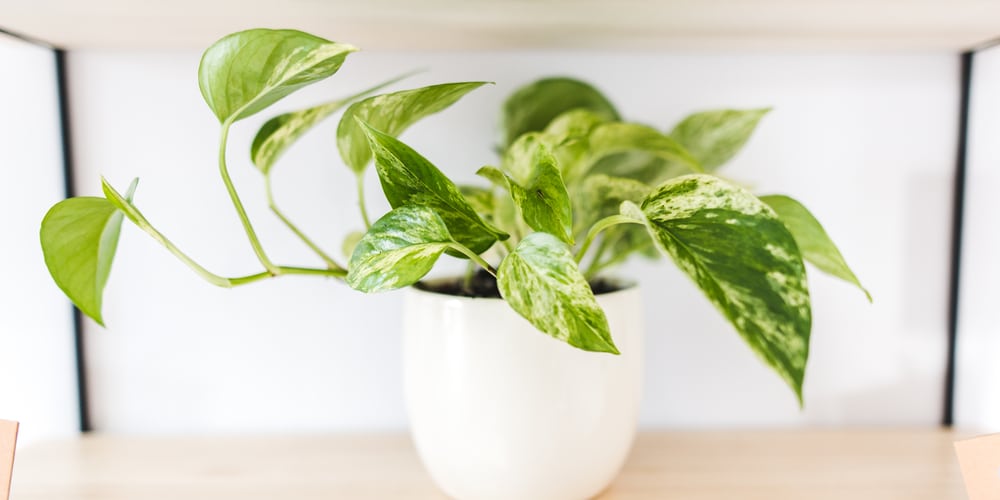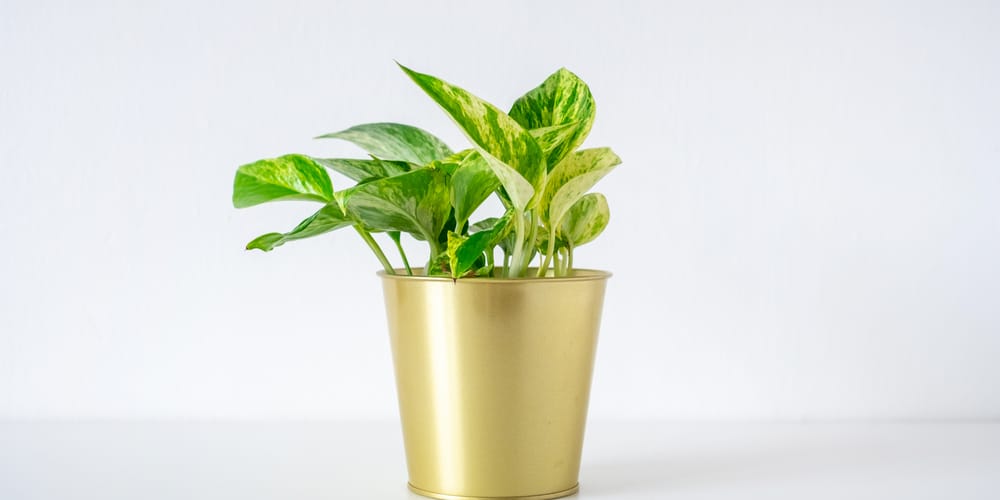The Marble Queen Pothos is a very popular houseplant that’s easy to care for. This plant requires bright light to produce the best foliage colors of white, green, yellow, or cream marble-like patterns on its leaves. It also requires medium water and high humidity for it to grow properly. This article will guide you on how to grow a marble queen pothos successfully in your home or office.
What is a Marble Queen Pothos?

Like many pothos plants, the Marble Queen originates from Asia and Oceania. It’s commonly found in countries such as China and India and the pacific islands, New Guinea and Australia.
The marble queen pothos plant gets its name from its variegated leaves with creamy white, green, and yellow vertical stripes. The foliage has a marble-like patterned effect. This beautiful houseplant grows upright and needs support from a stake or trellis, especially when quite large.
The Marble Queen can grow up to 30 feet tall in the wild with leaves that are a staggering 3 feet long. Indoor plants will be more compact.
The Marble Queen Pothos is part of the Araceae family, of which there are around 400 varieties of plants. Its botanical name is Epipremnum aureum, but like all pothos, these plants are commonly called Devils Ivy.
Pothos plants are highly toxic to humans and animals if ingested as their leaves and stems contain a substance called oxalic acid. Handling the vines and leaves can cause skin irritation in sensitive people; contact with eyes can cause permanent damage. Pothos is on the list of poisonous houseplants because of its toxicity, so it should be kept out of the reach of young children and animals.
Marble Queen Pothos Plant Care Guide

The Marble Queen Pothos is a tropical plant that is fairly easy to care for. Aim to get the basics such as temperature, humidity, watering, and sunlight right. Here are some tips which will help you grow a thriving Marble Queen Pothos plant:
Sunlight Needs
A Marble Queen Pothos prefers bright indirect light but shouldn’t be left in direct sunlight. Too much exposure to direct sunlight may cause sunburned spots on the leaves, which are dry-looking and more susceptible to pest infestation.
These plants can thrive outdoors in warmer climates (USDA Zones 9 to 11). In milder climates, they can be moved onto a patio on warm days. If placed outdoors during the summer months, make sure that they have partial shade during the day. This will allow the marble markings on the leaves to develop more prominently.
These plants can also be grown in rooms with low natural light if you use a grow light. Keep them between 4 inches (10 cm) away from fluorescent tubes when placed under artificial lights.
Temperature
Marble Queen Pothos aren’t very cold hardy and shouldn’t be left outdoors if frost is expected. The lowest temperature at night should not go under 55°F (12°C). If lower temperatures are expected, you may want to bring your plants indoors for winter. These plants grow best when the temperature is between 60 and 78F.
Watering Requirements
When watering Marble Queen Pothos, make sure to use tepid water. Watering too much can lead to root rot and pest infestation. Let the soil dry out between watering, and always test the soil with your finger to see if your plant needs to be watered. Never let this plant sit in water for too long, as this can cause root rot.
You’ll find that your pothos needs more water during the growing season from spring to fall. Watering can be reduced slightly in the winter as the plants will naturally go dormant and require less water as the weather colder.
Make sure not to overwater your pothos.
Humidity
Marble Queen Pothos likes high humidity of at least 50%. It’s best to place your plant on trays of moist pebbles. This will aid in better foliage development of its marble-like color markings. Do not mist the leaves because excess moisture can cause leaf spotting and fungal problems like rust or powdery mildew, which may kill the plant if left unchecked.
Soil
The Marble Queen Pothos requires slightly acidic soil with a pH range of between 6.1 and 6.5. These plants are fairly resistant and will adapt to soils that are slightly above or below this range. It’s best to grow a marble queen pothos in soil that’s loose and well-draining. You can add some organic matter such as perlite, moss, or peat to standard houseplant soil. Some people grow their pothos plant in water rather than soil, and this seems to work well.
Fertilizer
During the growing season, you can feed Marble Queen Pothos once a month with a diluted fertilizer specially formulated for tropical houseplants. You can either use a liquid fertilizer once a month or a slow-release fertilizer that can be applied two or three times during the year.
How to propagate a Marble Queen Pothos?

This Pothos can be propagated from a stem cutting and can be rooted in either water or soil. Whichever method you use, ensure that the cutting is taken from a healthy and mature stem. When pruning or taking stem cuttings from plants, it’s best to use a sterilized pair of scissors or knife, as this will help limit the spread of bacteria.
Once you’ve taken a cutting, dip the end in rooting hormone and plant it on a small container filled with moist peat moss and perlite. Alternatively, put the cutting in a glass of water if you want to watch the roots grow.
Pothos are generally easy to propagate and fast to grow. They will grow new roots and establish themselves quite quickly. Keep your newly propagated Marble Queen Pothos under bright light but not direct sunlight for at least three weeks until new roots have formed.
Conclusion
The Marble Queen Pothos is an excellent houseplant with beautiful marble-like markings on its leaves. Ensure that your plant is placed indoors near a window that gets some sunlight during the day. Keep your Marble Queen Pothos moist and improve the humidity by misting once in a while.